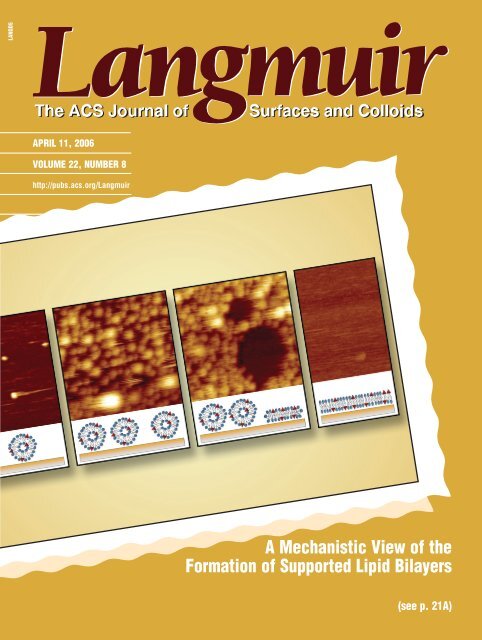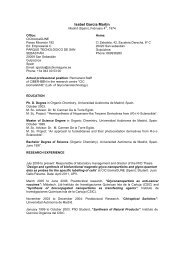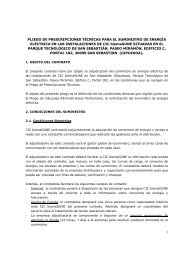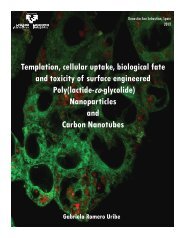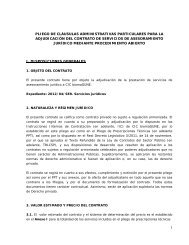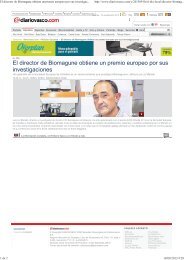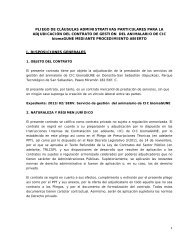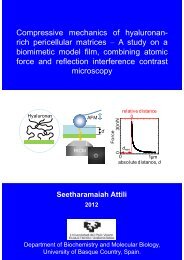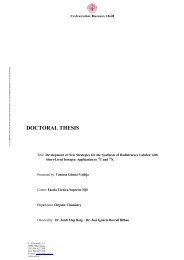A Mechanistic View of the Formation of ... - CIC biomaGUNE
A Mechanistic View of the Formation of ... - CIC biomaGUNE
A Mechanistic View of the Formation of ... - CIC biomaGUNE
Create successful ePaper yourself
Turn your PDF publications into a flip-book with our unique Google optimized e-Paper software.
LANGD5APRIL 11, 2006VOLUME 22, NUMBER 8http://pubs.acs.org/LangmuirA <strong>Mechanistic</strong> <strong>View</strong> <strong>of</strong> <strong>the</strong><strong>Formation</strong> <strong>of</strong> Supported Lipid Bilayers(see p. 21A)
Langmuir 2006, 22, 3497-35053497InVited Feature Article<strong>Formation</strong> <strong>of</strong> Solid-Supported Lipid Bilayers: An Integrated <strong>View</strong>Ralf P. Richter,* ,† Rémi Bérat, and Alain R. BrissonLaboratoire d'Imagerie Moléculaire et Nanobiotechnologie, IECB, UMR-CNRS 5471, UniVersité BordeauxI, 2 Rue Robert Escarpit, 33607 Pessac Cedex, FranceReceiVed October 4, 2005. In Final Form: NoVember 22, 2005Supported lipid bilayers (SLBs) are popular models <strong>of</strong> cell membranes with potential bio-technological applications.A qualitative understanding <strong>of</strong> <strong>the</strong> process <strong>of</strong> SLB formation after exposure <strong>of</strong> small lipid vesicles to a hydrophilicsupport is now emerging. Recent studies have revealed a stunning variety <strong>of</strong> effects that can take place during thisself-organization process. The ensemble <strong>of</strong> results in our group has revealed unprecedented insight into intermediates<strong>of</strong> <strong>the</strong> SLB-formation process and has helped to identify a number <strong>of</strong> parameters that are determinant for <strong>the</strong> lipiddeposition on solid supports. The pathway <strong>of</strong> lipid deposition can be tuned by electrostatic interactions and by <strong>the</strong>presence <strong>of</strong> calcium. We emphasize <strong>the</strong> importance <strong>of</strong> <strong>the</strong> solid support in <strong>the</strong> SLB-formation process. Our resultssuggest that <strong>the</strong> molecular-level interaction between lipids and <strong>the</strong> solid support needs to be considered explicitly,to understand <strong>the</strong> rupture <strong>of</strong> vesicles and <strong>the</strong> formation <strong>of</strong> SLBs as well as to predict <strong>the</strong> properties <strong>of</strong> <strong>the</strong> resultingSLB. The impact <strong>of</strong> <strong>the</strong> SLB-formation process on <strong>the</strong> quality and <strong>the</strong> physical properties <strong>of</strong> <strong>the</strong> resulting SLB aswell as implications for o<strong>the</strong>r types <strong>of</strong> surface-confined lipid bilayers are discussed.IntroductionBiological membranes play key roles in cell life, controlling<strong>the</strong> transfer <strong>of</strong> information and <strong>the</strong> transport <strong>of</strong> ions and moleculesbetween <strong>the</strong> inside and outside cellular worlds and participatingin various intra- and extracellular processes. These highly complexand dynamic assemblies, only a few nanometers thick, consist<strong>of</strong> two main components: a two-dimensional space made <strong>of</strong>lipid molecules held toge<strong>the</strong>r by hydrophobic interactions andself-assembled as a continuous bilayer and proteins embeddedwithin <strong>the</strong> membrane or transiently associated with it.Our current knowledge <strong>of</strong> <strong>the</strong> molecular processes occurringat biological membranes is based on studies performed both onintegrated and on reconstituted systems using models <strong>of</strong> biologicalmembranes. The deposition <strong>of</strong> model membranes on solidsupports has become very popular, 1-3 both for studying basicmembrane processes and for possible biotechnological applications.4-16 The growing interest in confining lipid membranes on* Corresponding author. E-mail: ralf.richter@urz.uni-heidelberg.de.† Current address: Department <strong>of</strong> Biophysical Chemistry, Institute <strong>of</strong>Physical Chemistry, Heidelberg University, Im Neuenheimer Feld 253, 69120 Heidelberg, Germany.(1) Sackmann, E. Science 1996, 271, 43-48.(2) Boxer, S. G. Curr. Opin. Chem. Biol. 2000, 4, 704-709.(3) Knoll, W.; Frank, C. W.; Heibel, C.; Naumann, R.; Offenhäusser, A.;Rühe, J.; Schmidt, E. K.; Shen, W. W.; Sinner, A. ReV. Mol. Biotechnol. 2000,74, 137-158.(4) Bieri, C.; Ernst, O. P.; Heyse, S.; H<strong>of</strong>mann, K. P.; Vogel, H. Nat. Biotechnol.1999, 17, 1105-1108.(5) Kung, L. A.; Kam, L.; Hovis, J. S.; Boxer, S. G. Langmuir 2000, 16,6773-6776.(6) Sapuri, A. R.; Baksh, M. M.; Groves, J. T. Langmuir 2003, 19, 1606-1619.(7) Sackmann, E.; Tanaka, M. Trends Biotechnol. 2000, 18, 58-64.(8) Knoll, W.; Park, H.; Sinner, E. K.; Yao, D.; Yu, F. Surf. Sci. 2004, 570,30-42.(9) Reviakine, I.; Brisson, A. Langmuir 2001, 17, 8293-8299.(10) Kam, L.; Boxer, S. G. Langmuir 2003, 19, 1624-1631.(11) Larsson, C.; Rodahl, M.; Höök, F. Anal. Chem. 2003, 75, 5080-5087.(12) Milhiet, P. E.; Giocondi, M.-C.; Baghdadi, O.; Ronzon, F.; Roux, B.; leGrimellec, C. EMBO Rep. 2002, 3, 485-490.(13) Yip, C. M.; Darabie, A. A.; McLaurin, J. J. Mol. Biol. 2002, 318,97-107.surfaces has been nourished by <strong>the</strong> emergence <strong>of</strong> a multitude <strong>of</strong>surface-sensitive characterization techniques, 5,17-19 advancedsurface patterning methods, 5,20-24 and liquid handling systems(micr<strong>of</strong>luidics). 10During <strong>the</strong> past decade <strong>the</strong> conceptual base <strong>of</strong> surface-confinedmembrane systems has grown considerably. A large number <strong>of</strong>systems has been described, including solid-supported lipidbilayers, 9,11,15,25,26 polymer-cushioned lipid bilayers, 27-29 hybridbilayers, 30,31 te<strong>the</strong>red lipid bilayers, 32 suspended lipid bilayers, 33,34(14) Salafsky, J.; Groves, J. T.; Boxer, S. G. Biochemistry 1996, 35, 5, 14773-14781.(15) Reviakine, I.; Bergsma-Schutter, W.; Brisson, A. J. Struct. Biol. 1998,121, 356-361.(16) Watts, T. H.; Brian, A. A.; Kappler, J. W.; Marrack, P.; McConnell, H.M. Proc. Natl. Acad. Sci. U.S.A. 1984, 81, 7564-7568.(17) Shao, Z.; Mou, J.; Czajkowsky, D. M.; Yang, J.; Yuan, J.-Y. AdV. Phys.1996, 45, 1-86.(18) Knoll, W. Annu. ReV. Phys. Chem. 1998, 49, 569-638.(19) Höök, F.; Larsson, C.; Fant, C. In Encyclopedia <strong>of</strong> Surface and ColloidScience; Marcel Dekker: New York, 2002; pp 774-791.(20) Srinivasan, M. P.; Ratto, T. V.; Stroeve, P.; Longo, M. L. Langmuir 2001,17, 7951-7954.(21) Michel, R.; Reviakine, I.; Su<strong>the</strong>rland, D.; Fokas, C.; Csucs, G.; Danuser,G.; Spencer, N. D.; Textor, M. Langmuir 2002, 18, 8580-8586.(22) Svedhem, S.; Pfeiffer, I.; Larsson, C.; Wingren, C.; Borrebaeck, C.; Höök,F. ChemBioChem 2003, 4, 339-343.(23) Morigaki, K.; Kiyosue, K.; Taguchi, T. Langmuir 2004, 20, 7729-7735.(24) Jackson, B. L.; Groves, J. T. J. Am. Chem. Soc. 2004, 126, 13878-13879.(25) Brian, A. A.; McConnell, H. M. Proc. Natl. Acad. Sci. U.S.A. 1984, 81,6159-6163.(26) Lenz, P.; Ajo-Franklin, C. M.; Boxer, S. G. Langmuir 2004, 20, 11092-11099.(27) Goennenwein, S.; Tanaka, M.; Hu, B.; Moroder, L.; Sackmann, E. Biophys.J. 2003, 85, 646-655.(28) Wagner, M. L.; Tamm, L. K. Biophys. J. 2001, 81, 266-275.(29) Munro, J. C.; Frank, C. W. Langmuir 2004, 20, 10567-10575.(30) Silin, V. I.; Wieder, H.; Woodward, J. T.; Valincius, G.; Offenhausser,A.; Plant, A. L. J. Am. Chem. Soc. 2002, 124, 14676-14683.(31) Terrettaz, S.; Mayer, M.; Vogel, H. Langmuir 2003, 19, 5567-5569.(32) Purrucker, O.; Förtig, A.; Jordan, R.; Tanaka, M. ChemPhysChem 2004,5, 327-335.(33) Römer, W.; Lam, Y. H.; Fischer, D.; Watts, A.; Fischer, W. B.; Göring,P.; Wehrspohn, R. B.; Gösele, U.; Steinem, C. J. Am. Chem. Soc. 2004, 126,16267-16274.(34) Römer, W.; Steinem, C. Biophys. J. 2004, 86, 955-965.10.1021/la052687c CCC: $33.50 © 2006 American Chemical SocietyPublished on Web 01/14/2006
3498 Langmuir, Vol. 22, No. 8, 2006 Richter et al.Figure 1. Surface-confined membrane models: (A) solid-supportedlipid bilayer; (B) polymer-cushioned lipid bilayer; (C) hybrid bilayer,consisting <strong>of</strong> a self-assembled monolayer (e.g., thiols on Au or silaneson glass or silica) and a lipid monolayer; (D) te<strong>the</strong>red lipid bilayer;(E) freely suspended lipid bilayer; (F-G) supported vesicular layers.or supported vesicular layers 22,35 (Figure 1). In parallel, a multitude<strong>of</strong> methods has been proposed to create such biomimetic edifices,including Langmuir-type approaches (Langmuir-Blodgett orLangmuir-Schäfer deposition) 36-39 and <strong>the</strong> spreading <strong>of</strong> vesicleson various preconditioned supports. 20,38,40-44The spreading <strong>of</strong> small lipid vesicles on hydrophilic solidsupports, pioneered by McConnell et al., 25 presents an attractiveand simple route to form supported lipid bilayers (SLBs). Theone-step procedure allows creating SLBs <strong>of</strong> different lipidmixtures. 45,46 The fact that such SLBs form a fluid twodimensionalspace allowing free diffusion in translation androtation <strong>of</strong> lipid molecules and lipid-associated proteins makes<strong>the</strong>m well suited to analyze lipid domain formation, 13,47-54intermembrane interactions, 55-57 or membrane processes such(35) Yoshina-Ishii, C.; Boxer, S. G. J. Am. Chem. Soc. 2003, 125, 3696-3697.(36) Swart, R. M. In Langmuir-Blodgett Films; Roberts, G., Ed.; PlenumPress: New York, 1990; pp 273-316.(37) Grandbois, M.; Clausen-Schaumann, H.; Gaub, H. E. Biophys. J. 1998,74, 2398-2404.(38) Wong, J. Y.; Majewski, J.; Seitz, M.; Park, C. K.; Israelachvili, J.; Smith,G. S. Biophys. J. 1999, 77, 1445-1457.(39) Ross, M.; Steinem, C.; Galla, H.-J.; Jansh<strong>of</strong>f, A. Langmuir 2001, 17,2437-2445.(40) Steinem, C.; Jansh<strong>of</strong>f, A.; Ulrich, W.-P.; Sieber, M.; Galla, H.-J. Biochim.Biophys. Acta 1996, 1279, 169-180.(41) Keller, C. A.; Kasemo, B. Biophys. J. 1998, 75, 1397-1402.(42) Starr, T. E.; Thompson, N. L. Langmuir 2000, 16, 10301-10308.(43) Zhao, J.; Tamm, L. K. Langmuir 2003, 19, 1838-1846.(44) Baumgart, T.; Offenhäusser, A. Langmuir 2003, 19, 1730-1737.(45) Richter, R. P.; Mukhopadhyay, A.; Brisson, A. Biophys. J. 2003, 85,3035-3047.(46) Richter, R. P.; Brisson, A. Biophys. J. 2005, 88, 3422-3433.(47) Mou, J.; Yang, J.; Shao, Z. J. Mol. Biol. 1995, 248, 507-512.(48) Reviakine, I.; Simon, A.; Brisson, A. Langmuir 2000, 16, 1473-1477.(49) Schneider, J.; Dufrêne, Y. F.; Barger, W. R., Jr.; Lee, G. U. Biophys. J.2000, 79, 1107-1118.(50) Rinia, H. A.; Kruijff, B. d. FEBS Lett. 2001, 504, 194-199.(51) Lawrence, J. C.; Saslowsky, D. E.; Edwardson, J. M.; Henderson, R. M.Biophys. J. 2003, 84, 1827-1832.(52) Tokumasu, F.; Jin, A. J.; Feigenson, G. W.; Dvorak, J. A. Biophys. J.2003, 84, 2609-2618.(53) Giocondi, M.-C.; Milhiet, P. E.; Dosset, P.; le Grimellec, C. Biophys. J.2004, 86, 861-869.(54) Jansh<strong>of</strong>f, A.; Bong, D. T.; Steinem, C.; Johnson, J. E.; Ghadiri, M. R.Biochemistry 1999, 38, 5328-5336.(55) Kaizuka, Y.; Groves, J. T. Biophys. J. 2004, 86, 905-912.(56) Parthasarathy, R.; Groves, J. T. Proc. Natl. Acad. Sci. U.S.A. 2004, 101,12798-12803.as protein adsorption, 58,59 protein self-assembly, 13,48,60 proteinlocalization at lipid phase boundaries, 12 or protein function. 37The self-organization steps involved in this methodsvesicleadsorption, rupture, and spreading into planar membranesspresent fundamental interest in colloidal and interfacial science.Both <strong>the</strong>oretical 61-63 and experimental work 41,45,64-70 during <strong>the</strong>past decade have considerably improved <strong>the</strong> general understanding<strong>of</strong> this process, and a detailed image <strong>of</strong> <strong>the</strong> structuralintermediates and <strong>the</strong> driving forces is now emerging. Figure 2shows four archetypes <strong>of</strong> lipid deposition processes, as followedby quartz crystal microbalance with dissipation monitoring(QCM-D). The QCM-D technique has proven very valuable toscreen <strong>the</strong> overall properties <strong>of</strong> <strong>the</strong> lipid deposition, 41 thanks to<strong>the</strong> dissipation parameter that allows distinguishing betweenintact, adsorbed vesicles (high dissipation) and bilayer patches(low dissipation). As shown in <strong>the</strong> schemes in Figure 2, vesiclesei<strong>the</strong>r do not adsorb (Figure 2A), adsorb and remain intact, givingrise to a supported vesicular layer (SVL) (Figure 2B), or forman SLB (Figure 2, panels C and D). Notably, SLB formation canoccur via two scenarios with distinctly different kinetics. In onecase, vesicles rupture quickly upon interaction with <strong>the</strong> solidsupport (Figure 2D), whereas in <strong>the</strong> o<strong>the</strong>r, a large amount <strong>of</strong>intact vesicles is adsorbed at an intermediate state <strong>of</strong> <strong>the</strong> process(Figure 2C).Recent technical developments, combining QCM-D and atomicforce microscopy (AFM), have allowed us to characterize <strong>the</strong>intermediate states leading to SLB formation in unprecedenteddetail. Here we present an overview <strong>of</strong> work performed in ourgroup that sheds light on <strong>the</strong> mechanisms and critical parametersinvolved in <strong>the</strong> formation <strong>of</strong> SLBs as well as on <strong>the</strong> propertiesand <strong>the</strong> quality <strong>of</strong> <strong>the</strong> resulting SLB.Mechanism <strong>of</strong> SLB <strong>Formation</strong>To satisfactorily describe <strong>the</strong> mechanism <strong>of</strong> SLB formation,two critical steps in this process need to be understood: (i) <strong>the</strong>adhesion and rupture <strong>of</strong> vesicles on <strong>the</strong> support and (ii) <strong>the</strong>evolution <strong>of</strong> <strong>the</strong> supported bilayer patches thus formed into acomplete SLB. Figure 3 provides an overview <strong>of</strong> mechanisms<strong>of</strong> vesicle rupture that have been reported or suggested in <strong>the</strong>literature.Stability <strong>of</strong> Adsorbed Vesicles. A simple rationale to evaluate<strong>the</strong> binding and <strong>the</strong> stability <strong>of</strong> surface-bound vesicles wasprovided by <strong>the</strong> <strong>the</strong>ory <strong>of</strong> Seifert and Lipowsky. 62,71 In <strong>the</strong>ircontinuum approach, where <strong>the</strong> bilayer is treated as a thin twodimensionalsheet embedded in three-dimensional space, <strong>the</strong>balance between <strong>the</strong> gain in adhesion energy (as given by <strong>the</strong>(57) Fix, M.; Melia, T. J.; Jaiswal, J. K.; Rappoport, J. Z.; You, D.; Söllner,T. H.; Rothman, J. E.; Simon, S. M. Proc. Natl. Acad. Sci. U.S.A. 2004, 101,7311-7316.(58) Corsel, J. W.; Willems, G. M.; Kop, J. M. M.; Cuypers, P. A.; Hermens,W. T. J. Colloid Interface Sci. 1986, 111, 544-554.(59) Andree, H. A. M.; Stuart, M. C. A.; Hermens, W. T.; Reutelingsperger,C. P. M.; Hemker, H. C.; Frederik, P. M.; Willems, G. M. J. Biol. Chem. 1992,267, 17907-17912.(60) Czaikowsky, D. M.; Shao, Z. FEBS Lett. 1998, 430, 51-54.(61) Seifert, U.; Lipowsky, R. Phys. ReV. A1990, 42, 4768-4771.(62) Seifert, U. AdV. Phys. 1997, 46, 13-137.(63) Zhdanov, V. P.; Keller, C. A.; Glasmästar, K.; Kasemo, B. J. Chem. Phys.2000, 112, 900-909.(64) Rädler, J.; Strey, H.; Sackmann, E. Langmuir 1995, 11, 4539-4548.(65) Keller, C. A.; Glasmästar, K.; Zhdanov, V. P.; Kasemo, B. Phys. ReV.Lett. 2000, 84, 5443-5446.(66) Jass, J.; Tjärnhage, T.; Puu, G. Biophys. J. 2000, 79, 3153-3163.(67) Reviakine, I.; Brisson, A. Langmuir 2000, 16, 1806-1815.(68) Johnson, J. M.; Taekijp, H.; Chu, S.; Boxer, S. G. Biophys. J. 2002, 83,3371-3379.(69) Reimhult, E.; Höök, F.; Kasemo, B. Langmuir 2003, 19, 1681-1691.(70) Benes, M.; Billy, D.; Benda, A.; Speijer, H.; H<strong>of</strong>, M.; Hermens, W. T.Langmuir 2004, 20, 10129-10137.(71) Lipowsky, R.; Seifert, U. Mol. Crys. Liq. Cryst. 1991, 202, 17-25.
<strong>Formation</strong> <strong>of</strong> Solid-Supported Lipid Bilayers Langmuir, Vol. 22, No. 8, 2006 3499Figure 2. Lipid deposition pathways measured by QCM-D on silica. (A) Vesicles do not adsorb. (B) Vesicles adsorb and remain intact,forming a supported vesicular layer (SVL). (C) Vesicles adsorb and remain initially intact. At high vesicular coverage an SLB is formed.(D) Vesicles adsorb and rupture instantaneously, to form an SLB. The dissipation, ∆D, allows distinguishing between <strong>the</strong> morphologicalstate <strong>of</strong> <strong>the</strong> adsorbed lipids: intact vesicles exhibit high dissipation while bilayer (patches) show low dissipation. The legends indicate <strong>the</strong>lipids usedsdioleoyltrimethylammonium-propane (DOTAP), dioleoylphosphatidylcholine (DOPC), and dioleoylphosphatidylserine (DOPS)swith <strong>the</strong>ir molar mixing ratios. 45Figure 3. Mechanisms <strong>of</strong> vesicle rupture: (A) an isolated adsorbed vesicle ruptures spontaneously, driven by its support-induced deformation;(B) neighboring adsorbed vesicles fuse and eventually rupture; (C) <strong>the</strong> active edge <strong>of</strong> a supported bilayer patch induces <strong>the</strong> rupture <strong>of</strong> aneighboring vesicle; (D) <strong>the</strong> cooperative action <strong>of</strong> several neighboring vesicles leads to <strong>the</strong> rupture <strong>of</strong> a first vesicle (at <strong>the</strong> critical vesicularcoverage). The active edge <strong>the</strong>reby exposed triggers <strong>the</strong> rupture <strong>of</strong> adjacent vesicles.adhesion area) and <strong>the</strong> cost in <strong>the</strong> vesicles’ curvature energy (asgiven by <strong>the</strong> bilayer’s bending rigidity) is determinant for <strong>the</strong>adsorption, deformation, and rupture <strong>of</strong> vesicles. Initial data inour group provided support for this model for egg-PC on mica. 67The examples given in Figure 2, panels A, B, and D, exemplify<strong>the</strong> scenarios were vesicles do not adsorb, adsorb intact, andrupture spontaneously, respectively.However, recent experimental data have provided evidencethat this continuum approach does not convey <strong>the</strong> whole answerto <strong>the</strong> question <strong>of</strong> vesicular stability under conditions commonlyemployed for SLB formation. Cooperative effects <strong>of</strong> neighboringvesicles as well as <strong>the</strong> dynamic distribution <strong>of</strong> different lipidspecies in a vesicle have to be taken into account for a betterdescription <strong>of</strong> <strong>the</strong> rupture propensity <strong>of</strong> surface-bound vesicles.Critical Vesicular Coverage. An intriguing effect <strong>of</strong> <strong>the</strong>cooperative action <strong>of</strong> surface-bound vesicles was first reportedby Kasemo and co-workers. By combining measurements byQCM-D and surface plasmon resonance (SPR) 65 toge<strong>the</strong>r withcomputer simulations, 63 <strong>the</strong> group could show (i) that isolatedvesicles <strong>of</strong> egg-PC remain intact when bound to a silica supportand (ii) that a certain surface density <strong>of</strong> vesicles (henceforwarddenoted <strong>the</strong> critical vesicular coverage) is required to initiate <strong>the</strong>decomposition <strong>of</strong> surface-bound vesicles into bilayer patches.Zhdanov and Kasemo 72 proposed that <strong>the</strong> support-induced stress(or deformation) <strong>of</strong> an adsorbed vesicle is fur<strong>the</strong>r enhanced by<strong>the</strong> adsorption <strong>of</strong> vesicles in its vicinity. When a certainconfinement <strong>of</strong> neighboring vesicles, corresponding to <strong>the</strong> criticalcoverage, is reached, <strong>the</strong> stress on <strong>the</strong> vesicle becomes sufficientto induce its rupture (Figure 3D).Figure 2C exemplifies <strong>the</strong> response obtained by QCM-D, when<strong>the</strong> critical vesicular coverage is involved. As techniques suchas QCM-D and SPR give average information about <strong>the</strong> adsorbedmaterial, a small fraction <strong>of</strong> prematurely ruptured vesicles maypotentially go undetected. 73 Our images by atomic forcemicroscopy (AFM) provide direct evidence that silica waferscan indeed be covered with vesicles that remain stable for days,being devoid <strong>of</strong> bilayer patches over areas <strong>of</strong> several squaremicrometers (Figure 4). 45 These images also demonstrate <strong>the</strong>(72) Zhdanov, V. P.; Kasemo, B. Langmuir 2001, 17, 3518-3521.(73) Reimhult, E.; Höök, F.; Kasemo, B. J. Chem. Phys. 2002, 117, 7401-7404.
3500 Langmuir, Vol. 22, No. 8, 2006 Richter et al.Figure 4. Imaging an intermediate <strong>of</strong> <strong>the</strong> SLB-formation processby AFM. Vesicles made <strong>of</strong> DOPC/DOPS (4:1) were exposed to asilica wafer. Spherical objects, identified as vesicles, densely populate<strong>the</strong> surface. No bilayer patches are visible, indicating that <strong>the</strong> criticalvesicular coverage is not attained. Image size (z scale): 2 µm (50nm). Adapted from ref 45. Copyright 2003 Biophysical Society.Figure 5. Tracing vesicle rupture kinetics by QCM-D. Vesiclesinitially adsorb intact but rupture into bilayer patches over <strong>the</strong> timerange <strong>of</strong> 30 min and more, as indicated by <strong>the</strong> decrease in dissipation(- - -) and <strong>the</strong> increase in frequency (-O-), after rinsing away vesiclesin solution (arrow). The AFM image (inset, image size: 750 nm ×500 nm), taken after <strong>the</strong> QCM-D measurement, confirms <strong>the</strong>coexistence <strong>of</strong> vesicles and bilayer patches. Adapted from ref 46.Copyright 2005 Biophysical Society.strength <strong>of</strong> <strong>the</strong> AFM to resolve <strong>the</strong> local morphology <strong>of</strong> <strong>the</strong> lipidassemblies down to nanometer resolution.Long-Term Stability <strong>of</strong> Adsorbed Vesicles. We observed apeculiar effect for vesicles containing a mixture <strong>of</strong> DOPC andDOPS when exposed to mica in a calcium-containing solution:when adsorbing vesicles at low surface density (i.e., <strong>the</strong> interaction<strong>of</strong> neighboring vesicles is negligible), <strong>the</strong>y initially remainedintact but ruptured individually over a time range <strong>of</strong> minutes tohours (Figure 5). 74 This strongly contrasted our commonobservation on silica supports that isolated vesicles ei<strong>the</strong>r ruptureimmediately (i.e., within less than a second) after adsorption orremain intact for days.What is <strong>the</strong> origin <strong>of</strong> such particular rupture kinetics? It appearsreasonable that a support-induced reorganization <strong>of</strong> <strong>the</strong> two lipidspecies within <strong>the</strong> adsorbed vesicle may lead to dynamic changesin <strong>the</strong> vesicle-support interaction and in <strong>the</strong> stability <strong>of</strong> <strong>the</strong>vesicles. The observed time range for rupture is, however, much(74) Richter, R. P.; Brisson, A. Biophys. J. 2005, 88, 3422-3433.Figure 6. Tracking <strong>the</strong> propagation <strong>of</strong> bilayer patch formation byAFM. (A) All vesicles are intact. (B) Two vesicle segments areresolved (arrowheads) followed by an extended bilayer domain,indicating <strong>the</strong> rupture <strong>of</strong> vesicles. The cross sections <strong>of</strong> threesuccessive scan lines (right) reveals that <strong>the</strong> two vesicles do notrupture simultaneoulsy: The right vesicle (white arrowhead) rupturesfirst (between scan line 1 and 2), likely induced by <strong>the</strong> AFM-tip.At scan line 3, <strong>the</strong> left vesicle (black arrowhead) is ruptured, likelyinduced by <strong>the</strong> “active edge” <strong>of</strong> <strong>the</strong> bilayer patch that is formed from<strong>the</strong> right vesicle. (C) The rupture <strong>of</strong> a single vesicle induces <strong>the</strong>transformation <strong>of</strong> several adjacent vesicles into a stable bilayer patch.A small gap (a few nanometers) separates <strong>the</strong> patch edge fromneighboring intact vesicles. A part <strong>of</strong> <strong>the</strong> image is distorted because<strong>the</strong> tip was accidentally retracted from <strong>the</strong> surface. Image size: 250nm. The slow scan direction is indicated with white arrows. Adaptedfrom ref 45. Copyright 2003 Biophysical Society.slower than <strong>the</strong> time needed for lipids within a single lipid leafletto reorganize. 75 We <strong>the</strong>refore propose that <strong>the</strong> translocation <strong>of</strong>lipids between <strong>the</strong> two leaflets <strong>of</strong> <strong>the</strong> vesicle is <strong>the</strong> parameterresponsible for <strong>the</strong> slow vesicle rupture. The suggested rupturemechanism correlates with our observation that mica induces anasymmetric inter-leaflet lipid distribution in SLBs, 76 an issuethat will be discussed in detail later on.Growth and Coalescence <strong>of</strong> Supported Lipid Bilayers. Oncea vesicle has ruptured, <strong>the</strong> resulting bilayer patch exposes anedge. 77,78 These edges are energetically unfavorable and, at leastfrom a <strong>the</strong>rmodynamic perspective, expected to promote <strong>the</strong>interaction with adjacent lipid material, such as <strong>the</strong> rupture <strong>of</strong>surface-bound vesicles (Figure 3C) or vesicles from solution.Provided <strong>the</strong> density <strong>of</strong> adsorbed vesicles is sufficiently high,such a process can propagate in a cascade <strong>of</strong> rupture eventsacross several neighboring vesicles and leads to <strong>the</strong> formation<strong>of</strong> extended bilayer patches. 45,63 The intermediate steps in thisprocess can be traced by AFM, as illustrated in Figure 6, andsuggest that <strong>the</strong> propagation speed is in <strong>the</strong> range <strong>of</strong> seconds. 45Fur<strong>the</strong>rmore, adjacent bilayer patches usually coalesce in order(75) Bernard, A.-L.; Guedeau-Boudeville, M.-A.; Jullien, L.; de Meglio, J.-M.Langmuir 2000, 16, 6809-6820.(76) Richter, R. P.; Maury, N.; Brisson, A. Langmuir 2005, 21, 299-304.(77) Kasson, P. M.; Pande, V. S. Biophys. J. 2004, 86, 3744-3749.(78) Jiang, F. Y.; Bouret, Y.; Kindt, J. H. Biophys. J. 2004, 87, 182-192.
<strong>Formation</strong> <strong>of</strong> Solid-Supported Lipid Bilayers Langmuir, Vol. 22, No. 8, 2006 3501Figure 8. Possible scenarios <strong>of</strong> <strong>the</strong> mutual interaction <strong>of</strong> neighboringvesicles. The surface-induced flattening <strong>of</strong> a newly adsorbing vesicleinduces <strong>the</strong> deformation <strong>of</strong> a neighboring one. If sliding and rollingare inhibited (A), <strong>the</strong> deformation represents a persisting stress for<strong>the</strong> vesicles, and facilitates <strong>the</strong>ir rupture. Sliding or rolling along <strong>the</strong>surface can release <strong>the</strong> stress (B). Thus, if sliding or rolling is enabled,neighboring vesicles can only induce added stress (and <strong>the</strong>rebyrupture) when a high overall packing <strong>of</strong> vesicles on <strong>the</strong> surface isattained.Figure 7. (A) Incomplete SLB made from DOPC/DOPS (4:1)vesicles on mica: bilayer patches are predominantly circular,indicating that <strong>the</strong>y are laterally mobile. Image size: 1 µm. (B)Incomplete SLB made from DOTAP-vesicles on silica. Some bilayerpatches (arrowheads) exhibit stable, strongly noncircular shapes.Image size: 1 µm. (C-F) Sequential images <strong>of</strong> patch coalescenceinduced by dynamic changes in <strong>the</strong> shape <strong>of</strong> a bilayer patch. After<strong>the</strong> merger <strong>of</strong> patches 1-3 (C), induced by <strong>the</strong> AFM-tip, <strong>the</strong>coalescence with patches 4 (D), 5-6 (E), and 7 (F) is generated bymovements <strong>of</strong> <strong>the</strong> reshaping patch. Image size: 1.75 µm. Adaptedfrom ref 46. Copyright 2005 Biophysical Society.to minimize <strong>the</strong>ir edge length. 45,46,67 Taken toge<strong>the</strong>r, <strong>the</strong>se effectsincrease <strong>the</strong> size <strong>of</strong> individual bilayer patches and <strong>the</strong> overallbilayer coverage and will, in <strong>the</strong> ideal case, lead to a completeSLB. 45,46Some <strong>of</strong> <strong>the</strong> vesicles imaged in Figure 6 remain intact eventhough <strong>the</strong>y are situated as close as a few nanometers to <strong>the</strong> edge<strong>of</strong> a bilayer patch. 45 This suggests that <strong>the</strong> edge almost needs tocontact a vesicle to induce its rupture and illustrates that <strong>the</strong>efficiency <strong>of</strong> edge-induced processes relies strongly on <strong>the</strong> spatialarrangement <strong>of</strong> vesicles and bilayer patches.Lateral Mobility <strong>of</strong> Vesicles and Bilayer Patches. Lipidassemblies as a whole can be laterally mobile and undergocollective shape changes, an effect not to be confused with <strong>the</strong>lateral diffusion <strong>of</strong> individual lipid molecules. The shape <strong>of</strong> bilayerpatches on <strong>the</strong> solid support provides a first indication about<strong>the</strong>ir mobility. Laterally mobile patches tend to reshape intocircular patches to minimize <strong>the</strong>ir line tension, an effect that weobserved on mica surfaces (Figure 7A). 46 In contrast, bilayerpatches on silica frequently retained a strongly noncircular shape(Figure 7B), providing evidence for <strong>the</strong> lack <strong>of</strong> mobility. 45It is instructive to compare our observations on <strong>the</strong> mobility<strong>of</strong> lipid assemblies on mica and on silica with data previouslyreported by Rädler et al. 64,79,80 With reflection interference contrastmicroscopy (RICM), <strong>the</strong>y observed that lipid bilayers, continuouslyformed from a deposited blob <strong>of</strong> concentrated DOPC inwater, easily slide over surfaces <strong>of</strong> both types <strong>of</strong> support. Thekinetics <strong>of</strong> <strong>the</strong> sliding motion on mica could be describedquantitatively by <strong>the</strong> shear flow <strong>of</strong> a thin water film that issandwiched between <strong>the</strong> solid support and <strong>the</strong> bilayer 81,82 andra<strong>the</strong>r high spreading coefficients <strong>of</strong> up to 40 µm 2 /s wereobtained. 79In light <strong>of</strong> <strong>the</strong> results by Rädler and co-workers, it was surprisingthat we found lipid assemblies to be immobile on silica. Also,<strong>the</strong> shape changes observed by us and o<strong>the</strong>rs 83 on mica seemconsiderably slower than postulated from <strong>the</strong> action <strong>of</strong> alubricating water film. 83 Variations in <strong>the</strong> employed experimentalconditions, in particular <strong>the</strong> presence <strong>of</strong> divalent ions 45,74,83 versuspure water, 64,79 may well be at <strong>the</strong> origin <strong>of</strong> <strong>the</strong> observeddifferences. However, <strong>the</strong> large range <strong>of</strong> variations in mobilityremains intriguing and points toward a current lack in understanding<strong>the</strong> coupling between <strong>the</strong> bilayer and <strong>the</strong> solid support.What kind <strong>of</strong> effects can be induced by <strong>the</strong> lateral mobility<strong>of</strong> lipid assemblies? The series <strong>of</strong> AFM images in Figure 7C-Fdemonstrates how dynamic changes <strong>of</strong> <strong>the</strong> patch shape canenhance <strong>the</strong> coalescence <strong>of</strong> neighboring bilayer patches. 46Similarly, vesicles are expected to rupture, induced by <strong>the</strong> activeedge <strong>of</strong> an approaching bilayer patch.The mobility <strong>of</strong> surface-bound vesicles also has importantimplications for <strong>the</strong> nature <strong>of</strong> <strong>the</strong> critical vesicular coverage.Mobile vesicles can avoid stress from neighboring vesicles bydisplacement along <strong>the</strong> surface (Figure 8B). Consequently, stressdue to intervesicle interactions can build up only when <strong>the</strong> oVerallvesicular coverage is high enough to force <strong>the</strong> vesicles to interact.The critical vesicular coverage is thus directly determined by <strong>the</strong>overall density <strong>of</strong> adsorbed vesicles. Given that intervesicleinteractions are commonly short-ranged, this implies that <strong>the</strong>critical coverage must be elevated. 72 In contrast, <strong>the</strong> shaperelaxation <strong>of</strong> immobile vesicles is constrained to <strong>the</strong> local(79) Nissen, J.; Gritsch, S.; Wiegand, G.; Rädler, J. O. Eur. Phys. J. B 1999,10, 335-344.(80) Nissen, J.; Jacobs, K.; Rädler, J. O. Phys. ReV. Lett. 2001, 86, 1904-1907.(81) Bayerl, T. M.; Bloom, M. Biophys. J. 1990, 58, 357-362.(82) Johnson, S. J.; Bayerl, T. M.; McDermott, D. C.; Adam, W. A.; Rennie,A. R.; Thomas, R. K.; Sackmann, E. Biophys. J. 1991, 59, 289-294.(83) Muresan, A. S.; Lee, K. Y. C. J. Phys. Chem. B 2001, 105, 852-855.
3502 Langmuir, Vol. 22, No. 8, 2006 Richter et al.environment (Figure 8A), and hence, <strong>the</strong> critical coverageoriginates in a local effect that involves a limited number <strong>of</strong>neighboring vesicles. In <strong>the</strong> minimal configuration, two immobilizedneighboring vesicles may be sufficient to inducerupture. Due to <strong>the</strong> statistical distribution <strong>of</strong> vesicles over <strong>the</strong>surface, <strong>the</strong> local effect, however, translates into an apparentcritical coverage <strong>of</strong> <strong>the</strong> ensemble. In this case <strong>the</strong> critical vesicularcoverage can thus span from very low to very high values, aswe could demonstrate for silica surfaces. 45Parameters that Govern SLB <strong>Formation</strong>Which pathway <strong>of</strong> vesicle deposition will be taken is essentiallydetermined by <strong>the</strong> interplay <strong>of</strong> bilayer-support, interbilayer, andintrabilayer interactions. In principle, <strong>the</strong> relative contribution<strong>of</strong> <strong>the</strong>se interactions will be susceptible to <strong>the</strong> nature <strong>of</strong> <strong>the</strong> support(its surface charge, chemical composition and roughness), <strong>the</strong>lipid vesicles (<strong>the</strong>ir composition, charge, size, and physical state),as well as <strong>the</strong> aqueous environment (its composition, pH andionic strength). In <strong>the</strong> following, we will outline some essentialexperimental parameters that appear to control SLB formation.Electrostatic Interactions. Several studies have pointed out<strong>the</strong> influence <strong>of</strong> <strong>the</strong> charge <strong>of</strong> support and lipids as well as <strong>the</strong>ionic strength <strong>of</strong> <strong>the</strong> solution on <strong>the</strong> adsorption <strong>of</strong> vesicles. 64,84-86In systematic studies on silica 45 and mica, 46 we provided evidencethat all four pathways <strong>of</strong> vesicle deposition outlined in Figure2 can actually be generated by varying one experimental parameteronly: <strong>the</strong> vesicle charge. These studies demonstrate that <strong>the</strong>SLB-formation process will be strongly influenced by electrostaticinteractions. Consequently, adjustments in <strong>the</strong> pH or in <strong>the</strong> ionicstrength are expected to constitute relatively simple means tooptimize <strong>the</strong> formation <strong>of</strong> SLBs for a given surface and a givenlipid composition. 85Calcium Ions. The influence <strong>of</strong> divalent ions in general andcalcium in particular appears notoriously surprising. The ions donot only participate in <strong>the</strong> screening <strong>of</strong> charges, <strong>the</strong>reby modifying<strong>the</strong> electrostatic interactions, but <strong>the</strong>y also directly interact, in<strong>of</strong>ten subtle ways, with surfaces and lipids. 48,87 As a generaltrend, calcium was found to promote <strong>the</strong> adsorption and rupture<strong>of</strong> vesicles and SLB formation. 45,67,84,88 Effects are particularlystrong on mica. 46,67,70 Often minor concentrations (mM and below)<strong>of</strong> <strong>the</strong> ion are sufficient to generate significant effects.Solid Support. The role <strong>of</strong> <strong>the</strong> solid support in <strong>the</strong> process<strong>of</strong> SLB formation cannot be underestimated. It is probably <strong>the</strong>most complex and still <strong>the</strong> most enigmatic parameter.Work on different supports has pointed out that hydrophilicityis a necessary 26 but not a sufficient condition to promote <strong>the</strong>rupture <strong>of</strong> vesicles and subsequent SLB formation. A number <strong>of</strong>reports has actually revealed difficulties to form SLBs on surfacessuch as gold, 41 SrTiO 2 , 42 TiO 2 , 42,73 or platinum, 69 leaving micaand silicon-based materials, such as glass, Si 3 N 4 , or silica, as <strong>the</strong>most common surfaces used for <strong>the</strong> preparation <strong>of</strong> SLBs. Progresson TiO 2 has though recently been reported, 89 again confirming<strong>the</strong> importance <strong>of</strong> electrostatic interactions and calcium.Although surface roughness in general was reported to haveconsiderable effects on <strong>the</strong> spreading <strong>of</strong> bilayers on solidsupports, 64,85 we experienced that SLB formation is only little(84) Nollert, P.; Kiefer, H.; Jähnig, F. Biophys. J. 1995, 69, 1447-1455.(85) Cremer, P. S.; Boxer, S. G. J. Phys. Chem. B 1999, 103, 2554-2559.(86) Hennesthal, C.; Steinem, C. J. Am. Chem. Soc. 2000, 122, 8085-8086.(87) Wilschut, J.; Hoekstra, D. Trends Biochem. Sci. 1984, 479-483.(88) Ekeroth, J.; Konradsson, P.; Höök, F. Langmuir 2002, 18, 7923-7929.(89) Rossetti, F. F.; Bally, M.; Michel, R.; Textor, M.; Reviakine, I. Langmuir2005, 21, 6443-6450.Figure 9. Transmission electron cryo-microscopy image <strong>of</strong> a silicananoparticlecovered by a nanoSLB. The silica nanoparticle appearsas a sphere <strong>of</strong> uneven density with a rough surface. The surroundingring <strong>of</strong> electron-dense material (green circle) corresponds to <strong>the</strong>outer lipid layer <strong>of</strong> an SLB covering <strong>the</strong> particle surface. The SLBtightly follows <strong>the</strong> particle’s corrugations (arrow) and does not leavesolvent-rich pockets. Scale bar: 20 nm. Adapted from ref 91 withpermission. Copyright 2005 American Chemical Society.affected by roughness in <strong>the</strong> nanometer range. 45,90,91 It isremarkable that SLBs can even be formed on silica filmsexhibiting extreme roughness and porosity at <strong>the</strong> nanoscale, suchas aerogels or xerogels, 92 even though <strong>the</strong> kinetics <strong>of</strong> SLBformation and <strong>the</strong> quality <strong>of</strong> <strong>the</strong> final bilayer seem substantiallyaffected under such conditions. An obvious question is to whatextent <strong>the</strong> SLB follows <strong>the</strong> support’s corrugations. An answerto this question has recently been given by imaging, bytransmission electron cryo-microscopy, <strong>of</strong> lipid vesicles adsorbedto and lipid bilayers surrounding silica nanoparticles. Membranecoatednanoparticles (Figure 9) illustrate that <strong>the</strong> lipid membranefollows very intimately <strong>the</strong> topography <strong>of</strong> <strong>the</strong> underlyingsupport. 91 The attraction between <strong>the</strong> solid support and <strong>the</strong> lipidmembrane is obviously strong enough to overcome <strong>the</strong> bilayer’sbending energy, inhibiting <strong>the</strong> formation <strong>of</strong> solvent-rich pocketsbetween SLB and support.Although relatively little acknowledged in <strong>the</strong> literature, <strong>the</strong>surface preparation may considerably influence <strong>the</strong> kinetics <strong>of</strong>lipid deposition and <strong>the</strong> nature <strong>of</strong> <strong>the</strong> lipid assembly that isultimately formed. 45 The hydroxylation state <strong>of</strong> silica surfaces,for example, can vary considerably, as a function <strong>of</strong> <strong>the</strong>manufacturing procedure, exposure to high temperature or tobasic solutions 93 and thus influence <strong>the</strong> charge 94 and o<strong>the</strong>rphysicochemical properties <strong>of</strong> <strong>the</strong> support. Apart from effects on<strong>the</strong> physicochemical state <strong>of</strong> <strong>the</strong> surface as a whole, surfacemanufacturing and preparation are susceptible to creating lateralheterogeneities in <strong>the</strong> surface properties. Some responses in <strong>the</strong>SLB formation have indeed been attributed to surface defects(“hot spots”). 68 The AFM images in Figure 10 present someexamples <strong>of</strong> lipid deposits on several glass surfaces provided bydifferent manufacturers. Even though all surfaces are essentiallysilica-like, substantial variability in <strong>the</strong> morphology <strong>of</strong> <strong>the</strong> lipiddeposits can be observed.The interaction between lipids and solid support can alsostrongly affect <strong>the</strong> properties 95,96 and <strong>the</strong> quality <strong>of</strong> <strong>the</strong> finalSLB. Some aspects will be discussed below.(90) Richter, R. P.; Brisson, A. Langmuir 2003, 19, 1632-1640.(91) Mornet, S.; Lambert, O.; Duguet, E.; Brisson, A. Nano Lett. 2005, 5,281-285.(92) Weng, K. C.; Stålgren, J. J. R.; Duval, D. J.; Risbud, S. H.; Frank, C. W.Langmuir 2004, 20, 7232-7239.(93) Iler, R. K. The Chemistry <strong>of</strong> Silica. Solubility, Polymerization, Colloidand Surface Properties, and Biochemistry; Wiley-Interscience: New York, 1979.(94) Toikka, G.; Hayes, R. A. J. Colloid Interface Sci. 1997, 191, 102-109.
<strong>Formation</strong> <strong>of</strong> Solid-Supported Lipid Bilayers Langmuir, Vol. 22, No. 8, 2006 3503Figure 10. Quality <strong>of</strong> <strong>the</strong> final SLB on different supports as imaged by AFM. (A) Glass cover slip (Deckgläser Nr. 1, Marienfeld GmbH,Lauda-Königsh<strong>of</strong>en, Germany): islands <strong>of</strong> many adsorbed vesicles remain stable for hours within <strong>the</strong> SLB. (B) Glass slide (Objektträgermit Mattrand, Knittel Gläser GmbH, Braunschweig, Germany): many individual vesicles remain intact within <strong>the</strong> SLB. (C) Silicon wafer:<strong>the</strong> SLB is homogeneous over areas <strong>of</strong> several µm 2 . Only a few defects, trapped vesicles, are visible (arrowheads). Surfaces, after cleaningwith SDS and UV/ozone, 45 were incubated with DOPC/DOPS (4:1)-vesicles at 2 mM CaCl 2 . Scale bar: 400 nm. The insets show respectivesurfaces prior to vesicle exposure at <strong>the</strong> same magnification. Imaging was performed as described in ref 46.Table 1. Amount <strong>of</strong> DOPS in <strong>the</strong> Bulk-Facing Leaflet <strong>of</strong> SLBsMade <strong>of</strong> DOPC and DOPSDOPS-content in <strong>the</strong>nominal DOPSbulk-facing leaflet (%)content (%) a on SiOb 2 on mica c on TiOd 20 0 0 010 10 3 ( 1 3380 >60 >60aAs determined by <strong>the</strong> mixing ratio <strong>of</strong> DOPS and DOPC in <strong>the</strong>vesicles. b From ref 97. c From ref 76. d From Figure 11.Interleaflet Distribution <strong>of</strong> Lipids in <strong>the</strong> SLBsLet us consider SLBs that are formed from vesicles containinga mixture <strong>of</strong> different lipid species. How are lipids distributedbetween <strong>the</strong> two SLB leaflets? This question, even though highlyrelevant for many applications, has until recently received ra<strong>the</strong>rlittle consideration. The interleaflet distribution is commonlyassumed to be symmetrical.We have investigated <strong>the</strong> adsorption behavior <strong>of</strong> prothrombinand annexin A5, two proteins that bind specifically toDOPS, to quantify <strong>the</strong> amount <strong>of</strong> DOPS in <strong>the</strong> bulk-facing lipidleaflet <strong>of</strong> SLBs containing both DOPC and DOPS. The ensemble<strong>of</strong> our results 76,97 provides evidence for a substantial degree <strong>of</strong>asymmetry in <strong>the</strong> interleaflet distribution <strong>of</strong> DOPS on mica. Forexample, an SLB that is formed from vesicles containing 20%DOPS exhibits a DOPS content in <strong>the</strong> bulk-facing leaflet <strong>of</strong>only 7% (Table 1). In contrast, we found <strong>the</strong> distribution <strong>of</strong>DOPS on silica to be symmetrical, within experimental error.The asymmetry on mica was suggested to originate from a specificcalcium-mediated interaction between <strong>the</strong> support andDOPS. 46,76Such an interaction is not restricted to mica. Recent studieson titanium oxide provide evidence for a similar, yet even strongerasymmetry in <strong>the</strong> distribution <strong>of</strong> DOPS (Figure 11, Table 1).These results suggest that an asymmetrical lipid distribution(95) Hetzer, M.; Heinz, S.; Grage, S.; Bayerl, T. M. Langmuir 1998, 14, 982-984.(96) Feng, Z. V.; Spurlin, T. A.; Gewirth, A. A. Biophys. J. 2005, 88, 2154-2164.(97) Richter, R. P.; Lai Kee Him, J.; Tessier, B.; Tessier, C.; Brisson, A.Biophys. J. 2005, 89, 3372-3385.Figure 11. Adsorbed amounts <strong>of</strong> annexin A5, a protein that bindsto DOPS in a calcium-dependent manner, to SLBs made <strong>of</strong> differentratios <strong>of</strong> DOPS and DOPC on silica (-0-), mica (-×-) and titaniumoxide (-]-). Annexin A5 was incubated at 2 mM CaCl 2 . Theresponses, given by <strong>the</strong> shifts, ∆f e , in QCM-D frequency, indicate<strong>the</strong> amounts that remain bound after removing excess annexin A5from solution. The sigmoidal curves are shifted toward higher nominalDOPS contents for mica and titanium oxide, indicating that lessDOPS is accessible in <strong>the</strong> SLB’s bulk-facing leaflets on <strong>the</strong>sesupports.<strong>of</strong> lipids in SLBs may be more prominent than commonlyappreciated.Integrity <strong>of</strong> <strong>the</strong> Final SLBsDirect or indirect evidence for <strong>the</strong> presence <strong>of</strong> defects in SLBshas frequently been reported. Defects were attributed to <strong>the</strong> choice<strong>of</strong> <strong>the</strong> employed lipids 45 and <strong>the</strong>ir mixture, 9 <strong>the</strong> preparation <strong>of</strong><strong>the</strong> liposomes, or <strong>the</strong> preparation <strong>of</strong> <strong>the</strong> solid support. The AFMimages on glass samples in Figure 10, panels A and B, illustratethat <strong>the</strong> formation <strong>of</strong> ideal SLBs cannot be taken for granted andthat <strong>the</strong> integrity <strong>of</strong> <strong>the</strong> final SLB needs to be validated.The importance <strong>of</strong> defects in an SLB will depend on <strong>the</strong>envisaged application. The action <strong>of</strong> lipases (i.e., lipid digestingenzymes), for example, was proposed to be triggered by <strong>the</strong>presence <strong>of</strong> point-defects in <strong>the</strong> membrane. 37 A few such defects,even though <strong>the</strong>y cover much less than one percent <strong>of</strong> <strong>the</strong> surface,may thus considerably affect <strong>the</strong> lipase activity. On <strong>the</strong> o<strong>the</strong>rhand, membranes that contain discontinuities that cover a fewpercent <strong>of</strong> <strong>the</strong> surface may be acceptable for o<strong>the</strong>r applications,such as protein adsorption studies.Methods to Characterize Defects. Whatever <strong>the</strong> application,appropriate characterization methods are required to determine<strong>the</strong> density and <strong>the</strong> nature <strong>of</strong> <strong>the</strong> defects in <strong>the</strong> SLB. In this
3504 Langmuir, Vol. 22, No. 8, 2006 Richter et al.Figure 12. “Trapped” vesicle. The surface-bound vesicle is locatedsufficiently far away to remain unaffected by <strong>the</strong> bilayer edges thoughclose enough to prevent <strong>the</strong> edge-induced rupture <strong>of</strong> o<strong>the</strong>r vesiclesfrom solution. We propose that such an arrangement inhibits <strong>the</strong>fur<strong>the</strong>r propagation <strong>of</strong> bilayer growth, leaving trapped vesicles asdefects.context, bulk methods such as QCM-D or ellipsometry can providean overall characterization <strong>of</strong> <strong>the</strong> state <strong>of</strong> <strong>the</strong> SLB and <strong>the</strong>intermediates in <strong>the</strong> SLB-formation process. However, localdefects that cover less than a few percent <strong>of</strong> <strong>the</strong> surface aredifficult to detect. A similar statement holds true for fluorescencerecovery after photobleaching (FRAP): <strong>the</strong> immobile fraction<strong>of</strong> molecules can rarely be determined to better than 1% and <strong>the</strong>detection <strong>of</strong> defects by fluorescence microscopy is limited by<strong>the</strong> optical resolution which exceeds <strong>the</strong> size <strong>of</strong> vesicles commonlyused to form SLBs. Only AFM appears capable <strong>of</strong> directlyvisualizing defects such as single holes or intact vesicles witha resolution in <strong>the</strong> range <strong>of</strong> a few nanometers. We note, however,that a careful control <strong>of</strong> <strong>the</strong> imaging conditions is required inorder to obtain reliable results, as AFM images may erroneouslypresent ideal bilayers, due to imaging artifacts. 74,90Apart from <strong>the</strong> effects that are due to <strong>the</strong> preparation <strong>of</strong> lipidsand support, one may wonder whe<strong>the</strong>r some <strong>of</strong> <strong>the</strong> abovediscussedmechanisms, which underlie <strong>the</strong> SLB formation, couldinherently be insufficient to generate a complete defect-free SLB.The AFM image in Figure 10C demonstrates that SLBs <strong>of</strong> highquality can be created on solid supports via <strong>the</strong> pathway in whichvesicle rupture is triggered by <strong>the</strong> critical vesicular coverage.The same is considered likely for <strong>the</strong> pathway in which vesiclesrupture individually, though conclusive evidence is yet lackingas our measurements were obstructed by contamination <strong>of</strong> <strong>the</strong>lipid sample.Investigations by Rädler et al. gave rise to <strong>the</strong> idea that slidingpromoting(or “self-healing”) surfaces should be ideal for <strong>the</strong>formation <strong>of</strong> defect-free SLBs. 1,64 However, we found SLBs <strong>of</strong>high quality under conditions where bilayer patches and vesicleswere virtually pinned to <strong>the</strong> surface. 45 This indicates that <strong>the</strong>mobility <strong>of</strong> lipid assemblies is not strictly necessary to formclose to ideal SLBs.Notwithstanding <strong>the</strong> indications that close to ideal SLBs canbe formed via <strong>the</strong> pathway <strong>of</strong> critical vesicular coverage, <strong>the</strong>spatial arrangement <strong>of</strong> surface bound vesicles and bilayer patchesmay in some cases inhibit fur<strong>the</strong>r propagation <strong>of</strong> bilayer growth.For example, a vesicle that is located sufficiently distant froman edge to remain undisturbed may still prevent <strong>the</strong> encounter<strong>of</strong> o<strong>the</strong>r vesicles from <strong>the</strong> solution with <strong>the</strong> edge (Figure 12).Such a vesicle, trapped in a bilayer hole, will thus stop bilayergrowth. From simple geometrical considerations, such an effectwould be expected to be more pronounced for larger vesicles.Indeed, a considerable amount <strong>of</strong> residual vesicles has beenreported in <strong>the</strong> case <strong>of</strong> larger vesicles on silica. 73 However, SLBformation from <strong>the</strong> smallest available vesicles seems to be largelydevoid <strong>of</strong> this effect.One application for which <strong>the</strong> quality <strong>of</strong> supported lipidmembranes has been a matter <strong>of</strong> recurrent discussion may bementioned here: <strong>the</strong> action <strong>of</strong> a few defects in <strong>the</strong> membranepotentially creates short circuits that disturb <strong>the</strong> measurement <strong>of</strong>ion transport through membranes or membrane-incorporatedproteins by electrosensing methods. 31,98 Despite frequentlyreported problems with <strong>the</strong> electrical properties <strong>of</strong> surfaceconfinedmembranes, no study has to <strong>the</strong> best <strong>of</strong> <strong>the</strong> authors’knowledge been undertaken to characterize <strong>the</strong> nature <strong>of</strong> <strong>the</strong>defects in detail. To date it remains <strong>the</strong>refore unclear how far<strong>the</strong> supported lipid bilayers used in <strong>the</strong> relevant studies correspondto <strong>the</strong> quality <strong>of</strong> <strong>the</strong> bilayers that we have reported here. Combinedapproaches with AFM, QCM-D, and electrosensing methodsmay provide valuable insight, to what extent SLBs can constitutesuitable membrane-mimics for <strong>the</strong> investigation <strong>of</strong> <strong>the</strong> channelproperties <strong>of</strong> membrane proteins.Conclusions and PerspectivesWe have described recent advancements in understanding <strong>the</strong>process <strong>of</strong> self-organization that leads from small vesicles inaqueous solution to a solid-supported lipid bilayer. Systematicstudies have allowed a number <strong>of</strong> mechanisms underlying SLBformation to be elucidated. Important insight in <strong>the</strong> involvedinteractions on <strong>the</strong> mesoscopic level has been gained, andparameters that are critical for <strong>the</strong> SLB-formation process havebeen identified.AFM and QCM-D, <strong>the</strong> main techniques employed in ourstudies, provide topographical information at <strong>the</strong> nanometer leveland quantitative physicochemical characterization <strong>of</strong> surfaceconfinedlipid assemblies, respectively. The combination <strong>of</strong> bothtechniques on identical supports has allowed for a considerableimprovement <strong>of</strong> our qualitative understanding <strong>of</strong> <strong>the</strong> SLBformation and opens up for a more quantitative assessment <strong>of</strong>this process.AFM, QCM-D, o<strong>the</strong>r methods, such as ellipsometry, SPR,fluorescence, electrosensing methods, and combinations <strong>the</strong>re<strong>of</strong>,constitute now an established toolbox for <strong>the</strong> detailed characterization<strong>of</strong> SLB formation. These tools may help to elucidatea number <strong>of</strong> apparently simple, but still debated questions,including <strong>the</strong> orientation <strong>of</strong> <strong>the</strong> lipid layers after vesicle ruptureas well as <strong>the</strong> role <strong>of</strong> vesicle fusion (Figure 3B) in <strong>the</strong> SLBformationprocess. AFM has emerged as a unique tool toinvestigate defects in SLBs down to <strong>the</strong> nanometer level. Adetailed and yet quick characterization <strong>of</strong> <strong>the</strong> quality <strong>of</strong> SLBs,however, remains a challenge.The experimental approaches described here and <strong>the</strong> presentunderstanding <strong>of</strong> <strong>the</strong> mechanisms involved in SLB formation onsolid supports can easily be extended to more complex systems,such as <strong>the</strong> formation <strong>of</strong> SLBs from protein-containing liposomesas well as polymer-cushioned, te<strong>the</strong>red, or pore-spanning lipidbilayers. It is hoped that, thanks to <strong>the</strong> recent maturation inunderstanding <strong>the</strong> SLB-formation process, formerly ra<strong>the</strong>r“artistic” approaches to SLB formation will be replaced by awell-controlled technology, <strong>the</strong>reby extending <strong>the</strong> applicability<strong>of</strong> surface-confined lipid membranes.We have pointed out <strong>the</strong> important role <strong>of</strong> <strong>the</strong> solid supportin <strong>the</strong> SLB-formation process. The interaction between lipidsand support appears complex and a good understanding on <strong>the</strong>molecular level is still lacking. It is intriguing that <strong>the</strong> solidsupport does not only affect <strong>the</strong> properties <strong>of</strong> <strong>the</strong> SLBs but also<strong>the</strong> two-dimensional organization <strong>of</strong> proteins bound to it. 90,97Future work will need to elucidate <strong>the</strong> nature <strong>of</strong> <strong>the</strong> thin solventlayer that separates <strong>the</strong> lipid bilayer from <strong>the</strong> solid support 81,82and its effect on <strong>the</strong> diffusion <strong>of</strong> lipid molecules in each <strong>of</strong> <strong>the</strong>two bilayer leaflets.(98) Naumann, R.; Schiller, S. M.; Giess, F.; Grohe, B.; Hartmann, K. B.;Kärcher, I.; Köper, I.; Lübben, J.; Vasilev, K.; Knoll, W. Langmuir 2003, 19,5435-5443.
<strong>Formation</strong> <strong>of</strong> Solid-Supported Lipid Bilayers Langmuir, Vol. 22, No. 8, 2006 3505Acknowledgment. The authors acknowledge <strong>the</strong> contributions<strong>of</strong> <strong>the</strong>ir collaborators in Bordeaux and A.R.B.’s formergroup in Groningen. We thank Aleš Benda (Heyrovský Institute,Prague, Czech Republic) for discussions and providing <strong>the</strong> glassslides (Figure 10). This research was supported by <strong>the</strong> ConseilRégional d’Aquitaine (France), <strong>the</strong> Fonds EuropéendeDéveloppementRégional, and European Community Grant FP6-NMP4-CT2003-505868 “Nanocues”.LA052687C


